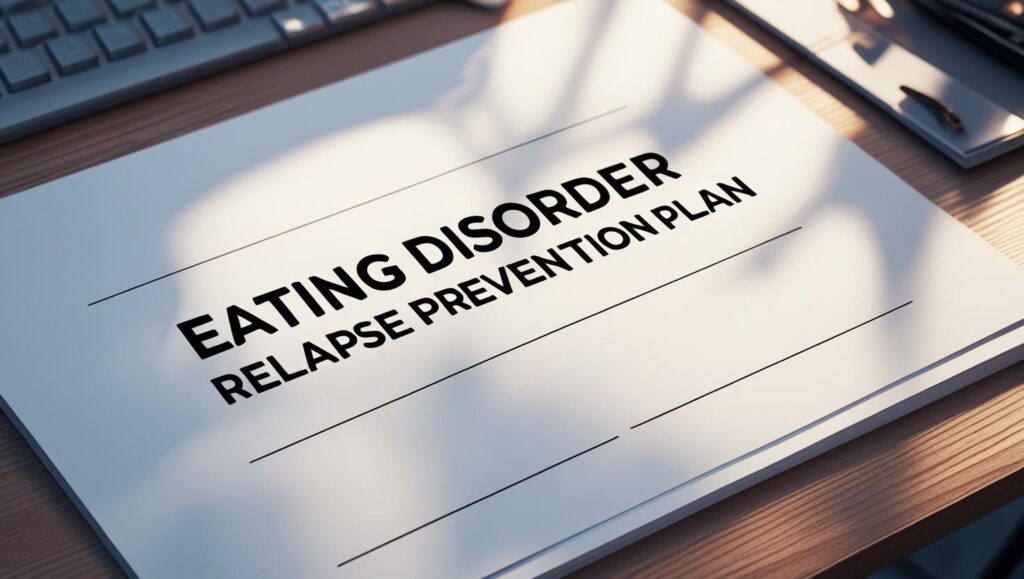How to Create a Relapse Prevention Plan for Eating Disorder Recovery
Creating a relapse prevention plan is one of the most powerful steps you can take in eating disorder recovery, and it’s something best done alongside your treatment team or eating disorder recovery coach. Having this plan in place early (before stressors or transitions like discharging from treatment) arise can give you a safety net to fall back on instead of old patterns. This is especially important for anyone heading into a big life change like starting college, where new pressures and environments can heighten vulnerability. Building the plan now means you’ll have clear strategies, supports, and reminders ready when you need them most.

What Is a Relapse Prevention Plan?
A relapse prevention plan is a personalized roadmap that outlines the warning signs, triggers, and coping strategies specific to you, so you can catch setbacks early and respond in a healthy way. It often includes practical tools like grounding techniques, support contacts, and reminders of your recovery values and goals. Instead of waiting until you’re in crisis, the plan gives you a clear guide for staying steady when challenges arise. Think of it as both a safety net and a compass, helping you protect your progress and keep moving toward long-term freedom.
Step 1: Increase Self-Awareness-Recognize Your Triggers and Warning Signs
A. Identify Your Eating Disorder Triggers
The first step in protecting your recovery is learning to notice what sets you off balance. Triggers can be emotional like stress or loneliness, situational such as exams or transitions, social like being in settings where food is central, or environmental like comments about body image or certain foods. Writing these down helps you see patterns and prepares you to respond differently instead of being caught off guard.
B. Spot Early Warning Signs
Alongside triggers, it’s equally important to spot the early warning signs that a setback might be building. These could include emotional cues like rising anxiety, physical changes such as fatigue, or behavioral shifts like avoiding meals or isolating. The more you tune in to these signals, the quicker you can take supportive action before slipping further.
Step 2: Develop Personalized Coping Strategies
A. Build Your Coping Tools
I work on building coping skill toolkits with my clients daily. I often hear clients say, “I’ve tried that but it just doesn’t work for me.” And when I dig deeper and ask why it doesn’t work, they might say something like, “because I don’t feel better right away.”
It’s important to understand that coping skills are not meant to eradicate the eating disorder thought or urge instantly. Coping skills need to be repeated with long periods of consistent practice in order to eventually help someone find relief. Taking the VIA Character Strengths Survey can help you identify your core character strengths, which often point to the coping tools that feel most natural and effective for you.
By leaning on strengths like perseverance, creativity, or social connection, you can personalize your recovery strategies in a way that feels authentic and sustainable.
B. Healthy Alternatives to Disordered Behaviors
There are a lot of different ways to practice self-care in eating disorder recovery. Let’s go through some of my favorite coping strategies. Meditation and breathwork can be particularly helpful for anyone experiencing anxiety or struggling with Obsesssive Compulsive Disorder. Many people find it comforting to practice reaching out to friends and family as a healthy alternative to using an eating disorder behavior.
Others find walking outside to be relaxing, while some prefer something artistic. Some of the more artistic activities my clients have enjoyed include: crochet, diamond art, paint by number, watercolor, junk journaling, and making a vision board.

Step 3: Set Realistic and Achievable Recovery Goals
A. Short-Term Goals
When creating your eating disorder recovery plan, it’s important to set short-term goals that feel doable and supportive in your day-to-day life. These might include eating regular meals, practicing self-compassion, or using one healthy coping strategy when a trigger shows up. Small, consistent steps create momentum and help build trust in yourself.
B. Long-Term Goals
Equally important are your long-term goals—the bigger picture of recovery you’re working toward. These could include maintaining stability with food, building new routines that support balance, and celebrating milestones in your healing. Having both short-term and long-term goals ensures your recovery plan keeps you grounded today while also focused on the freedom and peace you’re building for the future.
Step 4: Build and Strengthen Your Support System
A. Identify Your Support Network
Your support network can be made up of friends, family, a therapist, registered dietitian, psychiatrist, eating disorder recovery coach, and more. You may also seek an art therapist, a peer mentor, there are so many unique options nowadays to provide individualized support. The National Alliance for Eating Disorders has a treatment center and practitioner directory where you can find support based on state, type of insurance, type of provider, and more.
B. Communicate Your Needs and Relapse Prevention Plan
It’s incredibly important to make sure you share your relapse prevention plan with your eating disorder support system. They should know what signs and symptoms to look out for if you begin to struggle again. In my work as an eating disorder recovery coach, I often have meetings with clients and their parents and teams to discuss our prevention plan in depth. This meeting is standard with my clients going off to college.

Step 5: Prepare for High-Risk Situations and Stress Management
A. Planning Ahead
It’s important to have a plan for upcoming events, holidays, or vacations that could potentially be triggering. Ideally, you would discuss these dates in advance with your care team and come up with strategies to cope with your eating disorder triggers. In this blog post, I share 10 powerful CBT techniques for eating disorders. This may be helpful in assisting with finding strategies to cope with triggers.
B. Stress Management Techniques
I encourage all of my clients to follow an anxiety management system daily. Each person is unique in what helps them relax and find peace, but my favorite techniques are meditation and breathwork. Apps like Calm, Headspace, and Insight Timer are very popular for mindfulness. My personal favorite is the Open app due to it’s modern user interface and the amount of different meditation and breathwork techniques available. You can use this link to try it for a full month free.
Keywords: high-risk situations eating disorder, stress management relapse prevention.
Step 6: Create an Emergency Action Plan
A. Immediate Steps if You Notice Relapse Signs
If you start to notice signs of relapse, having an emergency relapse plan already outlined can make all the difference. Write down exactly who you’ll reach out to first, whether it’s a therapist, recovery coach, doctor, or trusted friend, so you don’t have to make that decision in the moment of stress. Include quick relapse prevention steps such as using a grounding tool, reaching out for accountability, or revisiting your meal plan if food patterns start to slip.
B. Review and Adjust Your Plan as Needed
Your needs in recovery will shift over time, so it’s important to schedule regular check-ins with yourself and your team to update your eating disorder relapse help plan. Reflect on what’s working, what new challenges have come up, and what supports you might need to add. This ongoing review process ensures that your action plan stays relevant and effective.
Importance of Professional Support and Therapy
Professional support is a cornerstone of eating disorder relapse prevention, because recovery isn’t something you’re meant to navigate alone. Therapists can help you process emotions and learn coping strategies, coaches can keep you focused on day-to-day recovery actions, and registered dietitians can provide structure and guidance around food. Involving these professionals in your relapse prevention plan gives you both accountability and expert insight, so you’re not relying solely on willpower when challenges arise.
This kind of professional support in recovery helps create an ongoing safety net, one that can be adjusted as your needs and life circumstances change.
Frequently Asked Questions about Eating Disorder Relapse
- How common is relapse in recovery?
Research indicates that more than one-third of individuals treated for anorexia or bulimia relapse within the first few years after completing treatment—specifically, around 35% for anorexia and up to 41% for bulimia. This data comes from Eating Recovery Center. However, this does not mean you WILL relapse. With a solid plan in place, your chances of staying successful in recovery increase.
- What should I do if I feel I’m relapsing?
If you feel like you are relapsing, it is important to contact your eating disorder recovery treatment team or someone in your support network immediately.
- Can relapse be part of recovery?
Relapse can be part of eating disorder recovery because recovery isn’t a straight line, your brain is rewiring old habits, and sometimes it slips back into familiar patterns. Each relapse is not a failure but an opportunity to learn what triggered it and how to respond differently next time. Over time, this process actually strengthens long-term recovery by building resilience and deeper self-awareness.

Conclusion
Having a concrete relapse prevention plan gives you something solid to lean on when recovery feels shaky. It helps you recognize triggers early, stay grounded in your values, and return to supportive tools instead of old patterns. Start building your plan today, even if it’s just writing down three coping strategies you can turn to when things get tough.
If you feel you need extra support, don’t hesitate to reach out to a professional who can guide you through this process. If this post was helpful, make sure you don’t miss future recovery strategies. Subscribe to my weekly newsletter, The Shift, for neuroscience-backed tools and fresh insights delivered straight to your inbox.
This article is for educational purposes and is not a substitute for medical advice. Please consult your treatment team for individualized care.
Published by Merrit Elizabeth, M.S., CCI-Certified Eating Disorder Recovery Coach on August 21, 2025.

Merrit Elizabeth Stahle is an Eating Disorder Recovery Coach certified by The Carolyn Costin Institute. She holds a master’s degree in Health Promotion Management and a certification in Applied Neuroscience. With many years of experience, she has worked with hundreds of clients, parents, and treatment team members to support lasting recovery. Fully recovered herself, she combines professional training with lived experience to help women rebuild trust, confidence, and freedom around food and body.

read or leave a comment +
Hide Comments –